VCU research: rapid evolution to integration and domain control
OEMs gradually realize independent supply amid the competitive landscape of VCUs for new energy passenger cars
The VCU is the "brain" of new energy vehicles. In the early development stage of China's new energy vehicle industry, VCUs were mainly supplied by foreign vendors. Afterwards, domestic automakers and automotive electronics suppliers have gradually mastered core technologies, so that their industrialization capabilities were greatly improved.
For example, BYD has fully realized independent supply of VCUs, Geely has continuously increased the proportion of self-produced VCUs to about 60%, almost 80% of Changan Automobile’s VCUs are produced by itself, and Chery can produce more than 90% of its own VCUs.
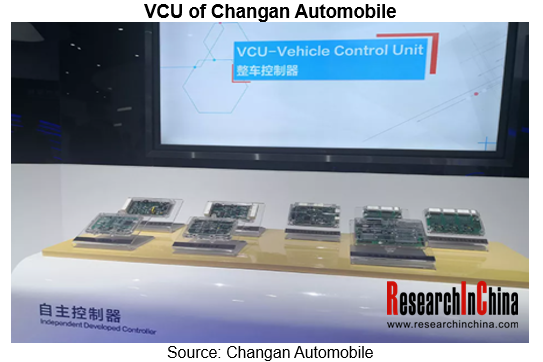
The VCUs of some OEMs or some models are purchased from third-party suppliers like UAES, Bosch, Continental, Denso, G-Pulse Electronics Technology, Atech, Hefei Softec Auto Electronic, Hangsheng Electronics, etc. Suppliers can provide their own software and hardware directly to OEMs, or they can be the foundries of OEMs.
The VCU market size is related to the output of new energy vehicles. By 2025, China new energy vehicle VCU market size will hit RMB5.03 billion (including self-supply of automakers).

Lightweight promotes the development of "electric drive + electric control + VCU" integrated system
In order to cater to the development trend of electrified, intelligent and lightweight vehicles, VCUs will tend to be highly integrated in the future. OEMs and Tier 1 suppliers have launched "all-in-one" electric drive systems, containing VCUs.
To further reduce the weight of new energy vehicles, improve product performance and ride comfort, BAIC started to try highly integrated products, followed by GM, Huawei, BYD, etc.. "Electric drive + electronic control + VCU" integrated systems have become the focus of OEMs and Tier 1 suppliers.
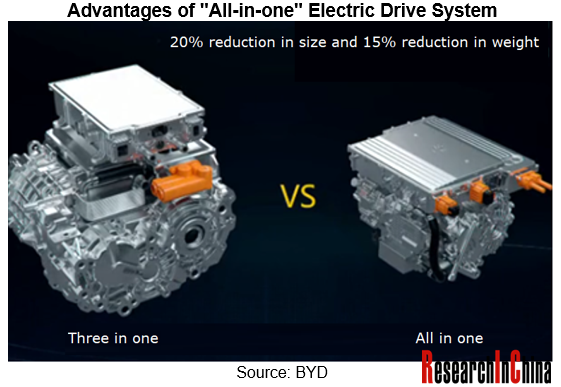
In September 2021, FinDreams Powertrain under BYD launched the "eight-in-one" electric powertrain, which deeply integrates drive motor, motor controller, reducer, automotive charger, DC converter, power distribution box, VCU, and battery manager.
One of the main purposes of BYD's "eight-in-one" integrated system is to reduce the weight of electric vehicles. It can realize the sharing of external high-voltage filters, external interface filter circuits and high-voltage sampling, as well as the in-depth integration of system DC, OBC, power distribution, transformers, inductors and VCU/BMC/MCU chips, so that an H-Bridge, transformers and a lot of high-voltage wiring harness are unnecessary, the magnetic module size is reduced by 40%, the overall volume is cut down by 16% (which can expand the riding space or increase the battery capacity), and the weight is slashed by 10% (which can further reduce power consumption).
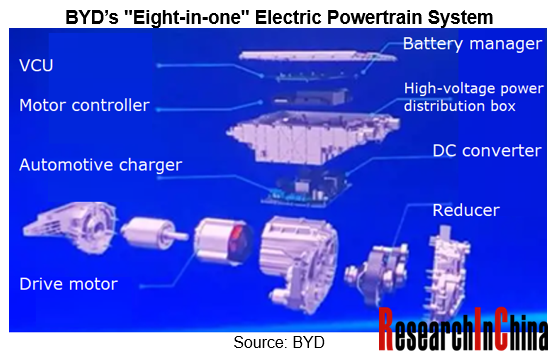
In July 2021, Changan Automobile released the second-generation electric drive integrated system, which combines seven components: VCU, high-voltage junction box, motor controller, DC converter, charger, motor, and reducer. Compared with the first-generation "three-in-one" (integrated motor, electronic control, and reducer) system, the second generation has been significantly improved in comprehensive performance, with the size reduced by 5%, the weight reduced by 10%, the power density increased by 37%, and the efficiency improved by 5%.
Changan Automobile expects to mass-produce next-generation super integrated electric drive in the second quarter of 2022, and which will be first deployed on C385, the first strategic model of the dedicated electric platform (EAP1).
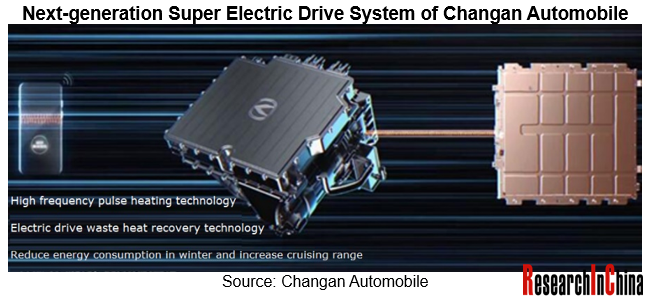
Under the new EEA, VCU develops towards domain control integration
From the perspective of evolution process, automotive E/E architecture (EEA) will inevitably develop towards centralized EEA. From the perspective of mass-produced models, domain-centralized EEA prevail now. The quasi-central architecture consisting of the central computing platform + zonal controllers will be the next step for automakers who finally evolve towards the central computing architecture concentrating the functional logic to a central controller.
With the evolution of the vehicle's EEA, the "all-in-one" electric drive system will eventually be integrated into the domain control system. For example, Huawei's "seven-in-one" DriveONE electric drive system has the most eye-catching domain control solution. The integration of modules, systems, scenarios and solutions effectively improves the system security.
(1) VCUs are integrated into domain controllers
For the development of vehicle EEA, the VCUs of the domain control architecture can be integrated into domain controllers. For example, ENOVATE integrates VCU and BMS to form the first-generation power domain controller VBU with completely independent research and development.
Hardware: The VBU uses Infineon's tri-core processor, has rich I/O resources, and supports Fast Ethernet;
Software: AUTOSAR architecture. The software architecture and interface protocol comply with AUTOSAR 4.2.2;
Application: At present, the VBU has integrated vehicle control, battery management, charging control, and extended range control.
Huawei's CC architecture includes 3 central controllers (smart cockpit, vehicle control, and smart driving) and 4 zonal controllers. Among them, the vehicle domain control (VDC) integrates the original VCU, adopts VOS system, and is compatible with AutoSar.
On the VDC platform, Huawei will develop an MCU and a vehicle control operating system which will be open to automakers, allowing automakers to perform differentiated vehicle control based on the VDC platform.

In April 2021, BYD released the e-platform 3.0, which gradually integrates dozens of ECUs in the vehicle into domain controllers of intelligent power domain, intelligent vehicle control domain, intelligent cockpit domain and intelligent driving domain; wherein, intelligent power domain integrates the control part of VCU, BMS, Inverter, PDU, DC/DC and AC/DC.

(2) VCUs are integrated into central computing unit
Under the central computing architecture, the central gateway degenerates into multiple zonal gateways, and VCU functions will be integrated into the vehicle control unit of the central computing unit.
For example, Volvo's hybrid central architecture includes a central computing platform, an intelligent interconnection module (IHU), and an autonomous driving module (ADPM) to integrate the original domain controllers into a central computing platform.
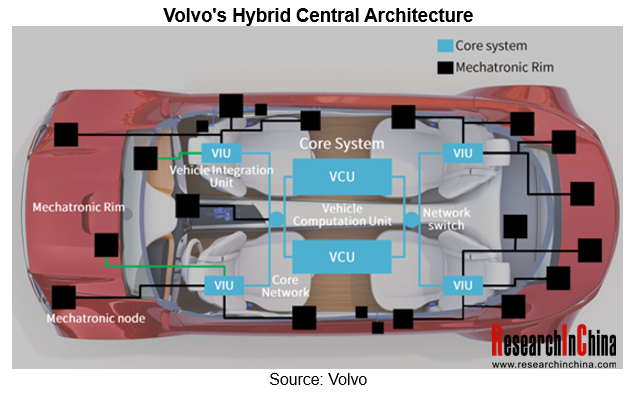
ResearchInChina’s New Energy Vehicle VCU Industry Report, 2021 mainly studies the following contents:
Industry overview, market size, competitive landscape, etc. of VCUs for new energy vehicles;
Industry chain, status quo of upstream and downstream of VCUs for new energy vehicles;
The impact of the EEA reform on VCUs for new energy vehicles, the development trend of VCU technology, etc.;
VCU solutions of some OEMs (such as BYD, ENOVATE, Changan, etc.);
VCU solutions of major domestic and foreign suppliers.
China Automotive Cybersecurity Hardware Research Report, 2022
Cybersecurity hardware research: security chip and HSM that meet the national encryption standards will build the automotive cybersecurity hardware foundation for China.
1. OEMs generally adopt the s...
China Automotive Cybersecurity Software Research Report, 2022
Chinese in-vehicle terminal PKI market will be worth RMB1.89 billion in 2025.
The working principle of PKI (Public Key Infrastructure) is: the infrastructure that provides security services establish...
Global and China HD Map Industry Report, 2022
HD maps have been applied on a large scale, spreading from freeways to cities
According to ResearchInChina, more than 100,000 Chinese passenger cars were equipped with HD maps by OEMs in the first ha...
Automotive Software Providers and Business Models Research Report, 2022
Research on software business models: four business forms and charging models of automotive software providers.
In an age of software-defined vehicles, automotive software booms, and providers step u...
China Automotive Integrated Die Casting Industry Research Report, 2022
Integrated Die Casting Research: Upstream, midstream and downstream companies are making plans and layouts in this booming field
Automotive integrated die casting is an automotive manufacturing proce...
Emerging Automakers Strategy Research Report, 2022--Xpeng Motors
XPeng Motors Strategy Research: Landing Urban NGP and Expanding Three Branch BusinessesXPeng P7 drives overall sales growth, and three new models will be launched from 2022 to 2023 to drive new growth...
Global Passenger Car Vision Industry Report, 2022
Foreign automotive vision research: leading Tier 1 suppliers vigorously deploy DMS/OMS, and vital sign detection becomes a standard configuration for OMS.
1. The revenues of major Tier 1 suppliers in...
China Automotive Vision Industry Report, 2022
China automotive vision research: DMS is booming, with the installations soaring 141.8% year-on-year
1. China will install 75.4 million cameras in 2025
According to ResearchInChina, China installed ...
C-V2X (Cellular Vehicle to Everything) and CVIS (Cooperative Vehicle Infrastructure System) Industry Report, 2022
C-V2X industry research: C-V2X was pre-installed in more than 20 production passenger car models, with a penetration rate of over 0.5%.
More than 20 production passenger car models were equipped wit...
New Energy Vehicle Thermal Management System Market Research Report,2022
Thermal Management Research: Technological Innovation and Iteration Have Spawned Emerging Markets
The rapid development of Chinese new energy vehicles has brought more opportunities for parts and com...
CTP, CTC and CTB Integrated Battery Industry Research Report, 2022
Integrated battery research: three trends of CTP, CTC and CTB
Basic concept of CTP, CTC and CTB
The traditional integration method of new energy vehicle power system is CTM, that is, "Cell to Module...
China Driving Recorder Market Research Report, 2022
Driving recorder research: sales volume of passenger cars equipped with OEM DVRs increased by 52.5% year-on-year in 2022 H1
In April 2021, the Ministry of Industry and Information Technology s...
Autonomous Delivery Vehicle Industry Report, 2022
Research on autonomous delivery: the cost declines, and the pace of penetration and deployment in scenarios accelerate.
Autonomous delivery contains outdoor autonomous delivery (including ground-base...
China Autonomous Heavy Truck Industry Report, 2022
Autonomous heavy truck research: entering operation and pre-installed mass production stage, dimension reduction and cost decrease are the industry solution
ResearchInChina released "China Autonomous...
China Smart Parking Industry Report, 2022
Smart parking research: there are 4,000 players, and city-level parking platforms have been established.
Smart parking market shows great potentials, and Baidu, Alibaba, Tencent and Huawei (BATH) hav...
Automotive Head-up Display (HUD) Industry Report, 2022
Automotive HUD research: AR HUD is being largely mounted on vehicles, and local suppliers lead the way. 1. AR HUD is being used widely, with 35,000 vehicles equipped in the first half of 2022.
S...
Intelligent Vehicle E/E Architecture Research Report, 2022
E/E architecture research: 14 key technologies, and innovative layout of 24 OEMsKey technologies of next-generation electronic and electrical architectures (EEA)
The definition of next-generation E/E...
China Automotive Lighting Market Research Report, 2022
Automotive lighting research: the penetration of ambient lights has reached 31%, and intelligent lighting is reshaping the third living space.
Favorable policies and consumption upgrade help automake...